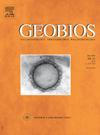Study of the shape and size in lower molars of Toxodon platensis (Mammalia: Toxodontidae) of the Late Pleistocene of South America
IF 1.6
4区 地球科学
Q2 PALEONTOLOGY
引用次数: 0
Abstract
This study aims to assess shape and size variations in lower molars (m1-m3) of Toxodon platensis Owen across diverse South-American regions: northern Pampa, Mesopotamia, northwestern Argentina (NWA), southwestern Uruguay, and southern Brazil. We examined 102 specimens, capturing 20 landmarks for each molar. Principal component analyses were used for shape analysis, and geographic origin relationships were explored through cluster analysis. Centroid size (CS) was analyzed with ANOVA. The shape of T. platensis molars differed among different populations in each geographic region. Molars from NWA exhibited a slenderer shape, whereas Mesopotamia specimens displayed more robust trigonids. Northern Pampa and southwestern Uruguay molars were the most similar in shape, and the molars of the populations in southern Brazil showed more curved morphologies. CS was similar among the different populations of T. platensis, which suggests a probability of similar food particle fracture and processing. On the other hand, when observing shape variations as a result of diet, it can be concluded that the shape changes observed in different geographic areas could be related to the type of vegetation consumed by various T. platensis populations.
南美晚更新世platodon(哺乳纲:Toxodontidae)下磨牙形状和大小的研究
本研究旨在评估不同南美地区:潘帕北部、美索不达米亚、阿根廷西北部、乌拉圭西南部和巴西南部的platodon Owen下磨牙(m1-m3)的形状和大小变化。我们检查了102个标本,每个臼齿捕获了20个地标。形态分析采用主成分分析,聚类分析探讨地理起源关系。质心大小(CS)采用方差分析。在不同地理区域,不同种群的高原猿猴磨牙形态存在差异。来自NWA的臼齿表现出更细长的形状,而美索不达米亚的臼齿则表现出更坚固的三角形。潘帕北部和乌拉圭西南部的臼齿形状最为相似,而巴西南部种群的臼齿形态更为弯曲。不同platensis居群间的CS相似,说明可能存在相似的食物颗粒断裂和加工过程。另一方面,当观察到饮食引起的形状变化时,可以得出结论,在不同地理区域观察到的形状变化可能与不同platensis种群消耗的植被类型有关。
本文章由计算机程序翻译,如有差异,请以英文原文为准。
求助全文
约1分钟内获得全文
求助全文
来源期刊

Geobios
地学-古生物学
CiteScore
3.30
自引率
6.20%
发文量
28
审稿时长
6-12 weeks
期刊介绍:
Geobios publishes bimonthly in English original peer-reviewed articles of international interest in any area of paleontology, paleobiology, paleoecology, paleobiogeography, (bio)stratigraphy and biogeochemistry. All taxonomic groups are treated, including microfossils, invertebrates, plants, vertebrates and ichnofossils.
Geobios welcomes descriptive papers based on original material (e.g. large Systematic Paleontology works), as well as more analytically and/or methodologically oriented papers, provided they offer strong and significant biochronological/biostratigraphical, paleobiogeographical, paleobiological and/or phylogenetic new insights and perspectices. A high priority level is given to synchronic and/or diachronic studies based on multi- or inter-disciplinary approaches mixing various fields of Earth and Life Sciences. Works based on extant data are also considered, provided they offer significant insights into geological-time studies.
 求助内容:
求助内容: 应助结果提醒方式:
应助结果提醒方式:


